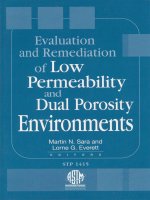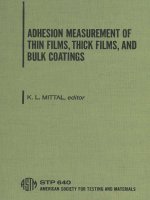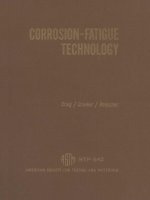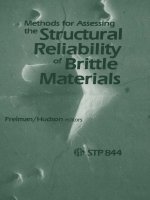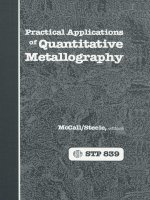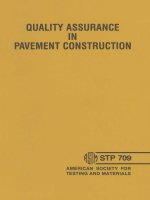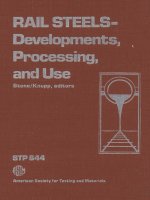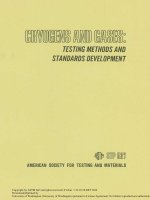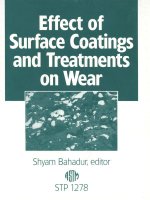Astm stp 1276 1996
Bạn đang xem bản rút gọn của tài liệu. Xem và tải ngay bản đầy đủ của tài liệu tại đây (3.52 MB, 198 trang )
STP 1276
Techniques to Assess the
Corrosion Activity of Steel
Reinforced Concrete Structures
Neal S. Berke, Edward Escalante, Charles K. Nmai, and
David Whiting, Editors
ASTM Publication Code Number (PCN):
04-012760-07
ASTM
100 Barr Harbor Drive
West Conshohocken, PA 19428-2959
Printed in the U.S.A.
l,ibrary of Congress Cataloging-in-Publication Data
Techniques to assess the corrosion activity of steel reinforced
concrete structures / Neal S. Berke ... [et al.], editors.
(STP ; 1276)
"ASTM publication code number (PCN) 04-012760-07."
Includes bibliographical references and index.
ISBN 0-8031-2009-5
1. Reinforcing bars--Corrosion--Testing. 2. Reinforced concrete-Corrosion--Testing #. Steel, Structural--Corrosion--Testing.
I. Berke, Neal Steven, 1952- . II. Series: ASTM special technical
publication ; 1276
TA445.5.T43 1996
620.1 '3723--dc20
96-35303
CIP
Copyright 9 1996 AMERICAN SOCIETY FOR TESTING AND MATERIALS, West Conshohocken,
PA. All rights reserved. This material may not be reproduced or copied, in whole or in part, in any
printed, mechanical, electronic, film, or other distribution and storage media, without the written
consent of the publisher.
Photocopy Rights
Authorization to photocopy items for internal, personal, or educational classroom use, or
the internal, personal, or educational classroom use of specific clients, is granted by the
American Society for Testing and Materials (ASTM) provided that the appropriate fee is paid
to the Copyright Clearance Center, 222 Rosewood Drive, Danvers, MA 01923, Tel: 508-7508400, online: http'J/www.copyright.com/.
Peer Review Policy
Each paper published in this volume was evaluated by three peer reviewers. The authors
addressed all of the reviewers' comments to the satisfaction of both the technical editor(s) and the
ASTM Committee on Publications.
To make technical information available as quickly as possible, the peer-reviewed papers in this
publication were prepared "camera-ready" as submitted by the authors.
The quality of the papers in this publication reflects not only the obvious efforts of the authors
and the technical editor(s), but also the work of these peer reviewers. The ASTM Committee on
Publications acknowledges with appreciation their dedication and contribution to time and effort on
behaff of ASTM.
Printed in Baltimore,MD
October 1996
Foreword
This publication, Techniques to Assess the Corrosion Activity of Steel Reinforced Concrete Structures, contains papers presented at the symposium of the same name, held on 7
December 1994. The symposium was sponsored by ASTM Committees G-1 on Corrosion
of Metals and C-9 on Concrete and Concrete Aggregates. Neal S. Berke of W. R. Grace and
Company in Cambridge, MA; Edward Escalante of NIST in Gaithersburg, MD; Charles K.
Nmai of Master Builders in Cleveland, OH, and David Whiting of Construction Technology
Labs in Skokie, IL, presided as symposium chairmen and are editors of the resulting
publication.
Contents
OverviewmN. s. BERKE
vii
MODELING
Modeling the Measured Time to Corrosion C r a c k i n g - - c D. NEWHOUSEAND
R. E. WEYERS
Progress on Design a n d Residual Life Calculation with Regard to Rebar
Corrosion of Reinforced C o n c r e t e - - c ANDRADEAND C. ALONSO
23
Predicting Times to Corrosion from Field a n d Laboratory Chloride D a t a - N. S. BERKE AND M. C. HICKS
41
C o m p u t e r Modeling of Effect of Corrosion Macrocells on Measurement of
Corrosion Rate of Reinforcing Steel in Concrete--A. A. SAGO~ AND
58
S. C. KRANC
Finite Element Modeling of G r o u n d Level Potential Measurements of Galvanic
Cells on Concrete PipemE. j. CARLSON, R. G. STRINGFELLOW,AND
74
S. C. HALL
CORROSION R A T E MEASUREMENTS
Field Measurement of the Corrosion Rate of Steel in Concrete Using a
Microprocessor Controlled Unit with a Monitored G u a r d Ring for Signal
ConfinementmJ. P. BROOMFIELD
91
Electrochemical Methods for On-Site Determinations of Corrosion Rates of
R e b a r s m s . FEI.IO, J. A. GONZALEZ,AND C. ANDRADE
107
Assessment of Corrosion of Steel in Concrete Structures by Magnetic Based
NDE Techniques--A. GHORBANPQOR AND S. SHI
119
Tests for Evaluation of the Effectiveness of Penetrating Sealers in Reducing
Penetration of Chlorides into Concrete--D. WHITING AND M. A. NAGI
132
C o m b i n e d Bulk and Interfacial Studies of the Cement/Steel System
Impedance Spectroscopy--s. J. FORD AND T. O. MASON
by
146
CASE STUDIES
Preliminary Corrosion Investigation of Prestressed Concrete Piles in a Marine
E n v i r o n m e n t : Deerfield Beach Fishing Pier--P. D. KRAUSS AND C. K. NMAI
161
Field Experience with R e b a r Probes to Monitor Performance of Sprayed Zinc
Galvanic Anodes on Concrete---A. A. SAGt~S AND R. G. POWERS
173
A Case Study: Assessment of Ice Rink Refrigerant Tubing Corrosion Using
Half Cell Techniques--w.
J.
BRXCKEV
185
Overview
The deteriorating infrastructure is a topic of major importance throughout the world. Steel
reinforced concrete is one of the most widely used construction materials, and as such, many
of the deteriorating structures are of reinforced concrete. This has occurred even though
steel-reinforced concrete is very durable, because this very durability has led to its use in
aggressive environments.
The purpose of the symposium, in which the papers in this special technical publication
(STP) were presented, is to explore techniques to determine the corrosion activity of steel
in reinforced concrete field structures. This is not an easy task due to the fact that the steel
is not visible, concrete has a high resistivity, and the structures are in use. Furthermore, the
structures are orders of magnitude larger than typical laboratory specimens and traditional
techniques, such as mass loss measurements and visual appearance of embedded steel are
not practical.
ASTM Committees G-1 on Corrosion of Metals, in particular G01.14 on Rebar Corrosion,
and C-9 on Concrete jointly sponsored the symposium. Both committees have active efforts
in determining corrosion rates and other factors such as permeability to the ingress and
chloride as well as other concrete properties that could affect performance. These committees
have been involved in producing several STPs related to the performance of concrete and
steel-reinforced concrete in the environment.
There are 13 papers in this STP that have been grouped into three major headings: Modeling, Corrosion Rate Measurements, and Case Studies. All of the papers address more than
one of these topics and several others; however, the major emphasis is in the area of the
major heading. Several of the papers address new methods of assessment or look at older
methods with new approaches, that are in some cases, controversial. The editors encourage
the readers to evaluate for themselves conclusions based upon the evidence given in the
papers and the included references. As a whole, the papers presented give a broad overview
that can be used in the assessment of steel-reinforced concrete in the field.
Modeling
The five papers in the Modeling section deal with using assessment information to predict
remaining service life, service life of similar newer structures, or current condition. They
combine the use of electrochemical measurements such as corrosion potential and corrosion
rate measurements.
The papers by Newhouse and Weyers and Andrade and Alonso address using corrosion
rate measurements to predict time to cracking. The first paper showed that chloride contents
and changing environmental conditions played major roles and that corrosion rate measurements were far from accurate. They also showed that Bazant's model for time to cracking
underestimated the times.
Andrade and Alonso looked at various approaches used to predict chloride ingress or
carbonation front movement. These techniques were combined with corrosion rate measurements and predicted corrosion product build-up to develop models to predict remaining
service life or service life of new structures.
vii
Copyright by ASTM Int'l (all rights reserved); Sat Dec 26 19:09:46 EST 2015
Downloaded/printed by
University of Washington (University of Washington) pursuant to License Agreement. No further reproductions authorized.
viii
OVERVIEW
Berke and Hicks determined chloride profiles for several field structures to calculate effective diffusion coefficients. These values were used to predict future chloride profiles from
which time to corrosion initiation could be estimated. They showed that laboratory predictions of diffusion coefficients based upon Test Method for Electrical Indication of Concrete's
Ability to Resist Chloride Ion Penetration (ASTM C 1202) were in good agreement with
field measurements on the same concrete. The potential benefits of using corrosion inhibitors
to significantly increase the threshold value of chloride for corrosion initiation were shown.
Kranc and Sagti6s, and Hall et al. discussed the use of models based on finite element
analyses. Kranc and Sagii6s show how finite difference computations can be used to correct
underestimations of the corrosion rates in large marine structures. Hall et ai. use finite element analysis of corrosion potential data on buried pipe to detect corroding areas and to
identify the detection limits of potential surveys.
Corrosion Rate Measurements
Five papers are included in this section. Two examine the use of guard ring electrodes,
one looks at electrochemical impedance spectroscopy, one at a magnetic-based nondestructive technique, and the last paper at techniques to evaluate sealers. It should be noted by the
reader that corrosion rate measurements are at best indicative of conditions existing at test
time, and given the changes in environment that occur in the field, can vary significantly
from day to day or even within a few hours due to changing moisture, temperature, and
chloride contents.
Broomfield et al. and Feliti et al. compare the use of guard ring electrodes to conventional
counter electrode and reference electrode techniques in determining corrosion rates of steel
in field structures. The papers show that the guard ring confines the current to a more welldefined area during polarization resistance so that a more accurate determination of the area
polarized can be made. This results in a more accurate representation of the corrosion rate.
Broomfieid et al. use the guard ring electrode to evaluate the performance of several
rehabilitation techniques that were applied to field structures.
Feliti et al. show that the corrosion rates are significantly lower at low corrosion rates for
the guard ring electrode. At higher corrosion rates or with larger counter electrodes the
corrosion rate without the guard ring approaches that of the guard ring. It is useful to review
the Newhouse and Weyers papers which showed that the guard ring underestimated corrosion
rates and the conventional techniques overestimated corrosion rates.
Ghorbanpoor and Shi showed that a magnetic field technique can determine a 3% reduction in cross-sectional steel area. More research is needed with this new application that
could offer an additional nondestructive technique that shows cumulative corrosion damage
to the time of measurement.
Ford and Mason use electrochemical impedance spectroscopy to examine steel in cement
pastes. They use ultra-high frequencies in the MHz range to determine diffusivity and permeability of the paste. Frequencies in the Hz range provide information on the interfacial
zone between the steel and paste, and the lower frequencies mHz provide information on
passivity. Even though the techniques discussed are more suited for laboratory studies, predictions of permeability from laboratory data might be applicable to estimating service life.
The paper by Whiting and Nagi assesses the performance of penetrating sealers with two
new test techniques. One is a resistivity measurement and the other is based upon the absorption of water. Both techniques can be used in the field. Though not a corrosion technique,
the evaluation of the condition of sealers over time in the field can be used as a predictor
Copyright
ASTM Int'l
(all rights
Sat Dec
19:09:46 EST 2015
of future by
corrosion
activity
due reserved);
to the ingress
of 26
chloride.
Downloaded/printed by
University of Washington (University of Washington) pursuant to License Agreement. No further reproductions au
OVERVIEW
ix
Case Studies
Three papers on case studies are given. Two involve marine concrete structures and one
is of a corroding ice rink.
Krauss and Nmai provide an initial evaluation of a new fishing pier with an amine and
fatty acid admixture to reduce corrosion. They employed visual, chloride, and corrosion
potential analyses. They showed that high negative corrosion potential are not indicative of
corrosion activity in concrete submerged in sea water and that the initial condition of the
structure is good. The importance of developing base-line information for future studies is
emphasized.
Sagti6s and Powers evaluated the use of spray zinc anodes in several field locations in
Florida. They used short embedded rebar probes with switchable connectors so that various
cathodic protection parameters could be determined.
Brickey used corrosion potential mapping, chloride analyses, microscopy, and destructive
techniques to document and determine the cause of corrosion-induced damage in an ice rink.
The paper is useful in showing how to combine multiple techniques to solve a real world
problem.
The papers outlined here will give the reader a good background into the latest techniques
used in assessing steel-reinforced concrete structures and in modeling future service life
based upon the assessment. The reader will also see that considerable work remains in
refining techniques to accurately measure corrosion activity. I wish to thank my co-editors
Ed Escalante, NIST; Charles K. Nmai, Master Builders, Inc.; and David Whiting, Construction Technology Laboratories, for help in getting speakers, running sessions, reviewing papers, and selecting reviewers. They join me in gratefully acknowledging the efforts of the
authors and ASTM personnel that have made this publication possible.
Neal S. Berke
Co-editor and Chairman, G01.14 on Rebar Corrosion,
Grace Construction Products.
Copyright by ASTM Int'l (all rights reserved); Sat Dec 26 19:09:46 EST 2015
Downloaded/printed by
University of Washington (University of Washington) pursuant to License Agreement. No further reproductions authorize
Modeling
Copyright by ASTM Int'l (all rights reserved); Sat Dec 26 19:09:46 EST 2015
Downloaded/printed by
University of Washington (University of Washington) pursuant to License Agreement. No further reproductions authorized.
Charles D. Newhouse I and Richard E. Weyers2
MODELING THE MEASURED TIME TO CORROSION CRACKING
REFERENCE: Newhouse, C. D. and Weyers, R. E., "Modeling the Measured
Time to Corrosion Cracking," Techniques to Assess the Corrosion Activity of
Steel Reinforced Concrete Structures, ASTM STP 1276, Neal S. Berke, Edward
Escalante, Charles K. Nmai, and David Whiting, Eds., American Society for
Testing and Materials, 1996.
ABSTRACT: The deterioration models for reinforced concrete structures include a
period for time to corrosion cracking: time from initiation of corrosion to first cracking.
Theoretical equations for determining the time to corrosion cracking have been presented
but never validated. This paper reports on a study which was initiated to validate Or
modify a set of theoretical equations for field linear polarization, unguarded and guarded,
corrosion rate devices. The test variables included six corrosion rates, two concrete cover
depths, two reinforcing steel bar diameters and spacings, two exposure conditions
(indoors and outdoors), and one design concrete strength (water to cement ratio).
Influence of temperature and chloride content on the measured corrosion rates are
presented. Corrosion rates increase with increasing chloride content and corrosion rates
vary significantly with annual changes in temperature, highest in the spring and lowest in
the winter. Measured metal loss measurements were compared with the calculated metal
loss based on monthly corrosion rate measurements for both devices. The 3LP device
significantly over-estimated the amount of metal loss and the Geocor 3 device significantly
under-estimated the amount of metal loss based on average monthly measurements. The
theoretical time to corrosion cracking equations significantly under-estimated the time to
corrosion cracking using a uniform corrosion rate based on the measured metal loss.
KEYWORDS: corrosion, concrete cracking, chloride, corrosion measurement, corrosion
rate
1Graduate Student, Charles E. Via, Jr. Department of Civil Engineering, Virginia
Polytechnic Institute and State University, Blacksburg, VA 24061-0105.
2professor, Charles E. Via, Jr. Department of Civil Engineering, Virginia Polytechnic
Institute and State University, Blacksburg, VA 24061-0105.
3
Copyright by ASTM Int'l (all rights reserved); Sat Dec 26 19:09:46 EST 2015
Copyright9
by by
ASTM International
www.astm.org
Downloaded/printed
University of Washington (University of Washington) pursuant to License Agreement. No further reproductions authorized.
4
STEELREINFORCED STRUCTURES
The problem of chloride induced corrosion of reinforcing steel in concrete
structures is well known. The mechanism requires a threshold concentration of the
chloride ion to initiate corrosion, oxygen and moisture as the electrolyte. The severity of
the problem is illustrated by the condition of United States bridges. Forty percent of
576,665 bridges on the federal aid system are structurally deficient or functionally obsolete
LI]. Corrosion of the reinforcing steel in concrete bridges accounts for 40 percent of the
deficient bridges, 92,266 deficient bridges [1].
Limited resources requires cost-effective management of the protection, repair,
and rehabilitation of concrete bridges and other structures. Service lives and initial costs
are needed to cost-effectively manage our infrastructure. Service lives may be estimated
from deterioration models. The deterioration models for the chloride-induced corrosion
of steel reinforced concrete bridges consist of a rapid initial deterioration related to
construction procedures and quality, a chloride diffusion time period to a specified depth
based on a percentage of the reinforcing steel, a corrosion period (time from initiation to
cracking) followed by a rate of deterioration to a cumulative damage defined as the endof-functional-service-life [2.3].
Methods have been developed for estimating the amount of initial damage, the
chloride diffusion period, the rate of damage and definition of end-of-functional-servicelife for concrete bridges [3]. However, the corrosion period has not been determined and
thus presently can only be estimated [3]. This paper presents results from a study that was
initiated to estimate the time-to-corrosion cracking from measurements with an unguarded
and guarded linear polarization device and unvalidated theoretical equations.
THEORETICALEQUATIONS
Ba~ant presented the following theoretical equation for estimating the time to
corrosion cracking [41.
DAD
t , ~ . p,~.
Sj-~--
(1)
where
tcotr
-~-
time to corrosion cracking,
Pcca
=
function of the mass density of steel and rust,
D
=
reinforcing bar diameter,
AD
=
increase in bar diameter,
S
=
bar spacing,
=
rate of rust production per unit length of bar.
Copyright by ASTM Int'l (all rights reserved); Sat Dec 26 19:09:46 EST 2015
Downloaded/printed by
University of Washington (University of Washington) pursuant to License Agreement. No further reproductions authorized
NEWHOUSE & WEYERS ON TIME TO CORROSION CRACKING
5
The increase in bar diameter (AD) is a function of cover depth (L), concrete strength (ft),
bar diameter (D), and bar hole flexibility (8~). If the bar spacing is greater than 6D,
which is the condition for all cases in this study, the increase in bar diameter is equal to the
following:
L
A D . 2 f, ~- b~,
(2)
and the bar hole flexibility is equal to:
8~-
(l.,)~
~-~o 4L(L.D)
(3)
where
creep coefficient of concrete,
V
--
Poisson's ratio of the concrete,
E
=
elastic modulus of the concrete.
The theoretical failure mode for a condition in which the bar spacing (S) is greater than 6
times the bar diameter (D) is incline cracking.
CORROSION
RATE DEVICES
The corrosion rate devices used in this study do not measure the rate of corrosion
or rate of metal loss directly. The devices measure the corrosion current density (i =
amp/cm 2) which is directly proportional to the rate of metal loss, Faraday's First Law:
Weight of metal loss = kI~o,,t
(4)
where
k
=
electrochemical constant,
Ir
=
corrosion current, amps,
t
=
time.
The devices, 3LP and Geocor 3, used in this study employ the linear polarization
method to measure an instantaneous polarization resistance and the corrosion current
Copyright by ASTM Int'l (all rights reserved); Sat Dec 26 19:09:46 EST 2015
Downloaded/printed by
University of Washington (University of Washington) pursuant to License Agreement. No further reproductions autho
6
STEELREINFORCED STRUCTURES
density is calculated from the Stern-Geary equation:
k
(5)
where
k
=
constant based on the Tafel slopes,
Rp
=
polarization resistance.
The 3LP and Geocor 3 employ different Tafel slope values in the calculation of the
constant, k. Also, the Geocor 3 uses a guard ring to confine the polarization current to a
defined bar length and the polarization rate is automatically determined and applied based
on the rate of corrosion. The 3LP device does not use a guard ring and the rate of
polarization is operator dependent within a set of operational guidelines. Thus, the
magnitude of the corrosion current densities measured by the devices are significantly
different, particularly for the more passive conditions where the polarization currents tend
to spread out further over the assumed bar polarization length [5].
The operational manuals of the devices present the following interpretation of the
measured corrosion rates. Here liberties are taken, corrosion rate is really corrosion
current densities.
Measured i~o~, (pA/cm 2)
Expectation
<0.18
0.18 - 0.93
0.93 - 9.3
>9.3
No damage expected
Damage possible in 10-15 years
Damage possible in 2-10 years
Damage possible < 2 years
Measured i~o~r,(gA/cm z)
Expectation
< 0.1
> 0.2
No active corrosion
Active corrosion
EXPERIMENTAL DESIGN
A sensitivity analysis of Eq. 1 demonstrated that the rate of rust production (Jr)
significantly influenced the estimated time to corrosion cracking (t~o~), whereas the other
Copyright by ASTM Int'l (all rights reserved); Sat Dec 26 19:09:46 EST 2015
Downloaded/printed by
University of Washington (University of Washington) pursuant to License Agreement. No further reproductions authorize
NEWHOUSE & WEYERS ON TIME TO CORROSION CRACKING
7
parameters have a minor influence on the time to corrosion cracking [6]. Thus, the study
included 6 corrosion rates, 2 reinforcing bar spacings, 2 reinforcing bar diameters, 2
concrete cover depths, 2 exposure conditions (outdoors and indoors), and 1 concrete
strength (water to cement ratio). The corrosion rates were controlled by the amount of
admixed chloride. A total of 56 slabs were constructed. The slabs are 188 cm square and
20 cm thick. Each slab contained 5 steel reinforcing bars as the reinforcing steel, all other
reinforcement, top temperature and bottom reinforcement and temperature, was fiberglass
bar. The 5 top steel reinforcing bars were electronically isolated and thus only micro-cell
corrosior~ could take place on the stee! bar surfaces. A type T ~ermocouple was placed at
both of the center steel reinforcing bars in the center of the slab. Tables 1 and 2
summarize the experimental design. Table 3 presents the average fresh and hardened
concrete properties. The coarse aggregate is a crushed limestone and the fine aggregate a
natural silicious sand, ASTM C33 #57 stone and sand, respectively.
TABLE 1--Outdoor slab matrix
Admixed
Chloride,
kg/m 3
0.00
0.35
0.71
0.71
0.71
1.4
2.8
5.7
Bar
Size,
mm
Bar
Spacing,
crn
13
13
13
13
16
13
13
13
Number of Specimens
Cover Depth, cm
20
20
20
15
20
20
20
20
5
7.6
2
3
3
3
3
3
3
3
2
3
3
...
...
3
3
3
TABLE 2--Indoor slab mixture
Admixed Chloride
kg/m 3
Bar Size, mm
Bar Spacing, cm
Number of Specimens
Cover Depth, cm
5
0.00
0.35
0.71
1.4
2.8
5.7
13
13
13
13
13
13
20
20
20
20
20
20
2
3
3
3
3
2
Copyright by ASTM Int'l (all rights reserved); Sat Dec 26 19:09:46 EST 2015
Downloaded/printed by
University of Washington (University of Washington) pursuant to License Agreement. No further reproductions authorized.
8
STEEL REINFORCED STRUCTURES
TABLE 3--C~lf,~glg,~aiXml~
Batch Weights, kg/m 3
Ingzredient
Weight
Cement
376
Water
169
Coarse Aggregate
1056
Fine Aggregate
710
Property
W/C
Air content, %
Slump, cm
Compressive Strength @ 28 days, MPa
0.45
5
10
35
An initial series of corrosion rate measurements demonstrated that the rate of
corrosion along a bar and within a slab were relatively uniform with the greatest variability
being between slabs for a given series, matrix cell [6]. Thus, the number of corrosion rate
measurements were reduced to 2 or 3 measurements each month for each specimen.
Thus, 7 or 8 monthly corrosion rates were measured for each specimen series, matrix cell,
over the 2 year time period are presented in this paper.
RESULTS
Figs. 1, 2, and 3 present the average measured corrosion rates for the 3LP and
Geocor 3 devices as a function of time and season for the outdoor, 5 cm cover, 13 mm
bar, 20 cm spacing and the 0.0, 1.4, and 5.7 kg/m 3 admixed chloride content series,
respectively. The results presented in Figs. 1, 2, and 3 are typical for each matrix cell
specimens within an outdoor admixed chloride series. The indoor admixed chloride series
had the same corrosion rate magnitudes but the corrosion rates were relatively uniform
because the temperature and the moisture content of the indoor concrete were more
uniform than the outdoor specimens 1.7.].
As shown in Figs. 1, 2, and 3, the measured corrosion rates for the 3LP was
always greater than the Geocor 3 measurements, regardless of the admixed cMoride
content. In general, the 3LP measurements were 15 to 20 times greater than the Geocor 3
measurements. Factors which contributed to the difference in measured values are
different assumed Tafel slope values, differences in assumed bar polarization length
(unguarded versus guarded electrode), and rate of polarization. Tafel slope values and
guard electrodes would account for about a factor of 4 between the measurements [.7.].
Thus, a significantly large portion of the difference between the devices may be related to
the difference in the rate of polarization between the devices.
Figs. 1, 2, and 3 illustrate the influence of admixed chloride content, time and
season (moisture-temperature) effects on the rate of corrosion. In all cases, the initial
corrosion rate was relatively high and decreased with lime. For the zero admixed cMoride
content, this observation may be attributed to the formation of the passive layer which
may have taken as long as 9 months to completely form. After 9 months, the corrosion
rates were relatively constant considering seasonal effects. For the 1.4 and 5.7 admixed
chloride cases, the decreasing of corrosion rate with time may be related to reduction of
the cathode to anode area and the time for corrosion products to diffuse through a rust
layer.
Copyright by ASTM Int'l (all rights reserved); Sat Dec 26 19:09:46 EST 2015
Downloaded/printed by
University of Washington (University of Washington) pursuant to License Agreement. No further reproductions authorized.
1
t
i
0
/
0.4 t
Fall
5
Winter
i
i
[
i
10
Time
i
Spring Summer
15
Fall
:
!
i
i
~
i
I
i
i
20
Winter Spring
I
25
(Months)
I
monthly
average
corrosion rate profile for the 0.00 admixed chloride series,
Copyright by ASTM Int'l (all Fig.
rights1A--Typical
reserved); Sat3LP
Dec 26
19:09:46
EST 2015
Downloaded/printed by
University of Washington (University of Washington) pursuant to License Agreement. No further reproductions authorized.
O
o 0.6 ~-
o
.9 0.8 ~
C
~m
1.2 2
1.4
(l.tA/cm 2)
to
0
o
z
0
0
0
0
m
z
0
o9
m
.<
m
cOO
m
-r
O
m
z
t
i
2)
i
5
1
t
Winter
t
,
t
J
10
Spring
i
i
i
[
i
i
i
i
]
Time
i
Summer
r
15
l
Fall
I
I
Winter
20
I
i
Spring
I
25
(Months)
I
Fig. 1B--Typical Geocor 3 monthly average corrosion rate profile for the 0.00 admixed chloride series.
0.03 t , ,
0
0.04 ~/
I
t
Fall
Copyright by ASTM Int'l (all rights reserved); Sat Dec 26 19:09:46 EST 2015
Downloaded/printed by
University of Washington (University of Washington) pursuant to License Agreement. No further reproductions authorized.
~
0 0.05
~0.06
o
a~ 0.08
t~
n~
c- 0.07 ~-
0.09
(l~A/cm
0.1
m
CO
C
O
C
E~
m
O
O
ITI
Z
"13
69
-H
m
m
i-"
C3
NEWHOUSE & WEYERS ON TIME TO CORROSION CRACKING
++++++-. .
tO
+-+++0
O .,+.--
o,,
I"-
11
.....................9 ........-+++~++~+~
~++++
~::::+~i~:i:~:i~ii~ii~ii~iii+i
~ -..,
.
I,,,.,
o..
.
.
.
.
.
.
.
.
O
(,"~
,,
...................................................
II
..
-/: .....................
,."
E
. i
E
.............9
E
.... ....---+"
"'-.
o.
'O
................ ,S'~-. . . . . . . . . . . . . . . . . . . . . . . . . . . . . . . . . . . . . . . . . . . . . . . . . . . . . . . . . . . . . . . . .
~
~
e
0
'",,,
........................ +I+:: 2 ....................................................
<
e~e~ UO!SOJJO~)
Copyright by ASTM Int'l (all rights reserved); Sat Dec 26 19:09:46 EST 2015
Downloaded/printed by
University of Washington (University of Washington) pursuant to License Agreement. No further reproductions authorized.
t,O
o
o
o
o1
Corrosion Rate
o
~
o1
i,o
o
o1
t,~
I
....................................
::.:70 .............................................
.,.,Y
F;
P-.
f,.,f
O
..,
8
0
O1
,/
/
O
......................
'~.~.~1~.........................................................
/
IO
~0
O
0
8
j//
,/
_-4.
3
C
/,
3
3
(1)
71
,=,,&
/
O1
/
/
/
/
I'O
O
~o
QO
---;::;e .............::::::::::::::::::::::::::::::::::::
&
. . . . . . . . . . . . . . . . . . . . . . . . . . . .
o
""'"'O
~'1,o
83UN10N~18 G3ONOgNI3N 7331S
~L
Copyright by ASTM Int'l (all rights reserved); Sat Dec 26 19:09:46 EST 2015
Downloaded/printed by
University of Washington (University of Washington) pursuant to License Agreement. No further reproductions
4
0
c..)
0
6
o
--fi---~
'
8
i
i
5
I
10
t
i
i
q
i
i
n
i
,
:i
i
\,
Time
\\
Fall
}
iL
:p
i
.
t
,,
\\
15
"L
~:
.i
i
'
i
\\
\\
.
s
e
J
i
/
J
O/
/
20
i
i',
i
i
r
Winter Spring
Copyright by ASTM Int'l (all rights reserved); Sat Dec 26 19:09:46 EST 2015
Downloaded/printed by
University of Washington (University of Washington) pursuant to License Agreement. No further reproductions authorized.
25
(Months)
O
Fig. 3A--Typical 3LP monthly average corrosion rate profile for the 5,7 admixed chloride series.
t
J
I
/
i
//
/ //
o-Q
n
i
Spring Summer
i
i
n,"
r.0
0
'
", ~
i
i
i.
i
\\
Winter
~,
t
9 10
12
(l~A/cm2 )
Z
Q
0
o
o
o
o
o
m
--I
oZ
6o
t-n
...<
m
m
"r
O
t--
Z
m
0
I
I
k
I-
i
I
i
/
,/
,,
5
\
i
i
\\ i
10
\~
/
J
Q
Spring S u m m e r
Time
\\
Fall
I
15
1
\\\
-\
t
//
I
20
i
i
/' i
Spring
L~'~ I ~
Winter
i
O
I
25
(Months)
~
Fig. 3B--Typical Geocor 3 monthly average corrosion rate profile for the 5.7 admixed chloride series.
0.2
0.4
r
i
i O
i
i
i
Winter
Copyright by ASTM Int'l (all rights reserved); Sat Dec 26 19:09:46 EST 2015
Downloaded/printed by
University of Washington (University of Washington) pursuant to License Agreement. No further reproductions authorized.
0
O
~L
o
t/)
.o 0.6
t-
tv"
0.8
1
(#A/cm 2)
m
C
C
~0
rn
z
.,13
O
30
O
m
EJ
QO
--t
m
m
i"
..&
NEWHOUSE & WEYERS ON TIME TO CORROSION CRACKING
15
Relative to admixed chloride content, as shown in Figs. 1, 2, and 3, corrosion rates
increase with increasing admixed chloride contenL Note that the 0.35 series is
approximately equal to the 0.0 admixed chloride series and the 0.71 series lies in fietween
the 0.35 and 1.4 admixed chloride content series [2]. Figs. 1, 2, and 3 also show the
influence of seasonal effects, the interaction between temperature and moisture of the
concrete on the measured corrosion rate. The highest corrosion rates generally occur
during the Spring when temperatures and moisture increased in the outdoor exposure
area, at Virginia Tech in Blacksburg, Virginia. As Summer approaches, temperatures
increase but moisture decreases, as the concrete moisture content decreases, the corrosion
rate decreases because the resistance of the corrosion cell decreases. During Fall,
temperatures decrease and moisture increases but the corrosion rate decreases because
temperature is the controlling factor, during Winter the corrosion rate continues to
decrease because temperatures continue to decrease. The lowest corrosion rate occurs
during the Winter and the highest during the Spring. The annual corrosion rate may vary
by a factor of 4 to 6 and appears to interact with the chloride content, higher factors for
higher chloride content.
Measured corrosion rates presented in Figs. 1A, 2A, and 3A would be interpreted
as possible damage in 10-15, 2-10, in less than 2 years, respectively. Fig. 1A is the
corrosion profile for the 0.0 admixed chloride series where no corrosion damage would be
expected. Thus, one must question the accuracy of the interpretations presented in the
3LP users manual. For the Geocor 3, as shown in Figs. 1B, 2B, and 3B, only the 5.7
admixed chloride series appears to be actively corroding, based on the criteria presented in
the user's manual.
Figs. 4 and 5 present the average monthly corrosion rates for the same 5.7
admixed chloride series presented in Fig. 3 as a function of concrete temperature
measured at the bar depth. The measurements are presented separately for the time
periods 1-9 months and 11-23 months to illustrate the significant effect a decreasing
cathode to anode area ratio and diffusion of corrosion products through the rust layer has
on the measured values during the early months, see Figs. 1, 2, and 3. Measured
corrosion rates are less variable after 10 months. As shown in Fig. 4A, 3LP, 1-9 month
measurements, the corrosion rate appears to at best decrease with increasing time,
however, electrochemical reactions are known to increase with increasing temperature.
For the 1-9 month Geocor measurements presented in Fig. 5A, there appears to be a slight
increase with increasing temperature. However, after 10 months, both the 3LP and
Geocor 3 measurements increase with increasing temperature, as would be expected. The
3LP measurements increase by about a factor of 5 from 50 to 100~ (10 to 38~
whereas the Geocor 3 measurements increase by a factor of about 3 over the same
temperature range, see Figs. 4B and 5B. Note that the above observed temperature
factors are not the influence of temperature alone because the specimens were stored
outdoors where moisture and temperature vary as would be the case for field structures.
At 22 months, the outdoor, 5 cm cover, 20 cm spacing, 13 mm bar, 5.7 admixed
chloride series cracked. Cracking was vertical above the bar, not inclined cracking as
present in Ba~ant's equation. This was the only series to crack during the 24 month
measurement period reported here. Vertical cracking occurred in all 3 specimens in the
series within about a two week period. Three 5 cm bar sections were removed from the
Copyright by ASTM Int'l (all rights reserved); Sat Dec 26 19:09:46 EST 2015
Downloaded/printed by
University of Washington (University of Washington) pursuant to License Agreement. No further reproductions authorized
40
~
45
I
b
50
d
i
t..i
/
i
I
55
60
65
Temperature
I
70
i
i
75
I
0
t-.l".
S
Ii~o
O
Q
(~
1--
80
Copyright by ASTM Int'l (all rights reserved); Sat Dec 26 19:09:46 EST 2015
Downloaded/printed by
University of Washington (University of Washington) pursuant to License Agreement. No further reproductions authorized.
Fig. 4A--3LP average monthly corrosion rate for months 1-9 as a function of concrete temperature for the 5.7 admixed
chloride series presented in Fig. 3A, ~ = 5/9(~ - 32).
4
6
8
"-10
O
,_12
14
167
18
(~tA/cm 2)
C
-n
m
~o
~D
tO
oo
m
0
3o
137
z
m
m
~o
,...
I,,-,
2
4
6
8
40
i
50
60
]
/
80
i
9
Temperature
70
i
0
4
i
90
I
0
I
I
1O0
Oo
0
0
110
(~
~
Copyright by ASTM Int'l (all rights reserved); Sat Dec 26 19:09:46 EST 2015
Downloaded/printed by
University of Washington (University of Washington) pursuant to License Agreement. No further reproductions authorized.
Fig. 4B--3LP average monthly corrosion rate for months 11-23 as a function of concrete temperature for the 5.7 admixed
chloride series presented in Fig. 3A, ~ = 5/9(~ - 32).
=m
0
0
12t-
14
(#Mcm2)
..q
z
C)
.-n
0
z
0
c?
0
.-n
m
--4
0
z
.-I
o
m
(/)
-1O
c
co
m
z
m

